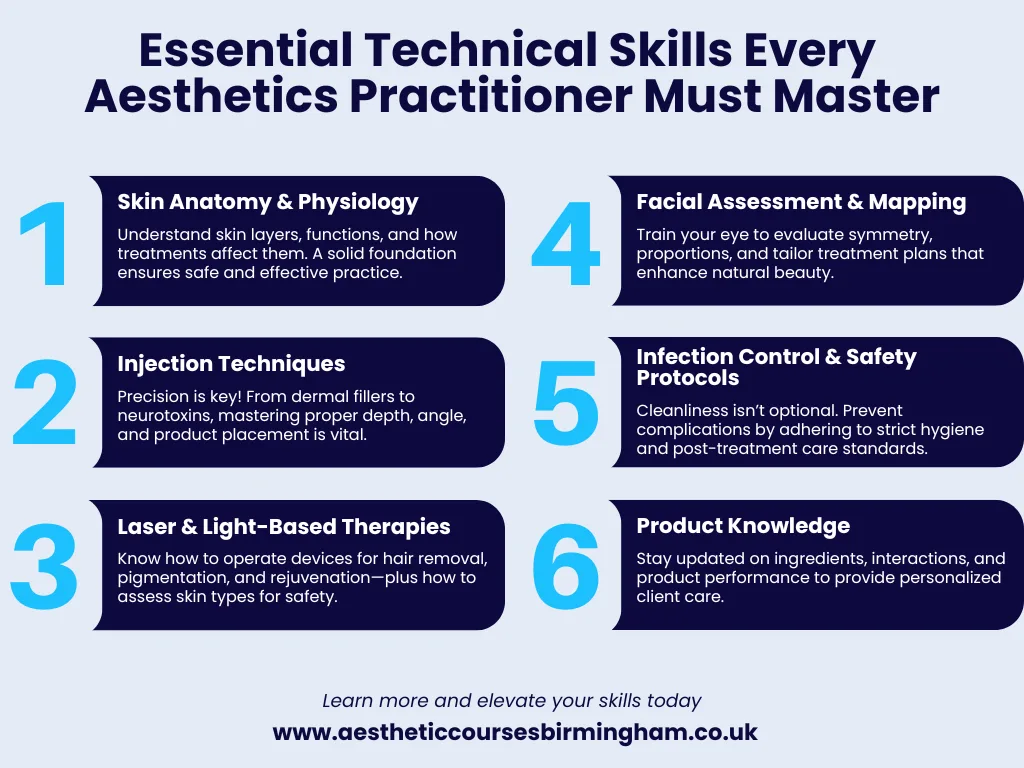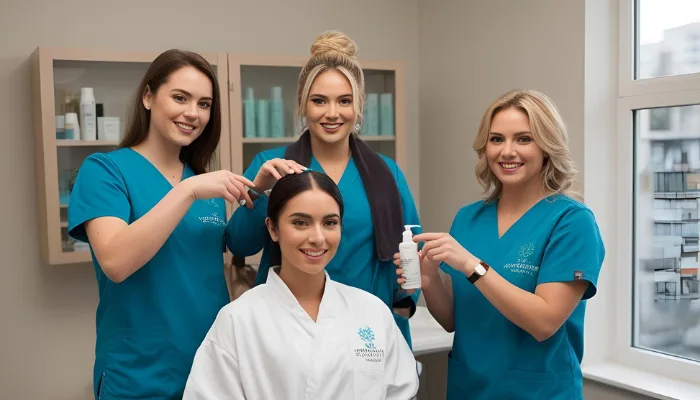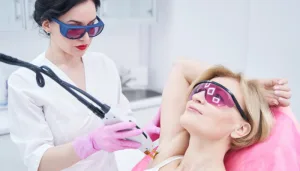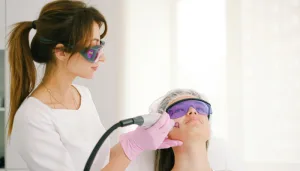
Starting your journey in aesthetic courses can feel a bit overwhelming, especially if you’re a complete beginner. There’s a lot to consider, from understanding what aesthetic practise actually involves to figuring out which course to take.
This guide aims to break down everything you need to know about how to start aesthetic courses for beginners, so you can make informed decisions and kick off your new career with confidence.
Key Takeaways
- Aesthetic courses cover various levels, from basic to advanced, catering to different skill sets.
- Identifying your personal goals is key to choosing the right course for you.
- Hands-on training is crucial for developing practical skills in aesthetics.
- Look for accredited courses to ensure quality education and recognition in the industry.
- Continuing education is important for staying current with trends and advancing in your aesthetic career.
Understanding Aesthetic Courses
Defining Aesthetic Practise
Aesthetic practise is all about enhancing a client’s appearance through cosmetic treatments. These treatments can range from non-invasive procedures like chemical peels and microdermabrasion to more advanced techniques such as injectables and laser therapy.
Aesthetic practise requires a blend of medical knowledge, technical skill, and an artistic eye. It’s not just about performing procedures; it’s about understanding facial anatomy, skin types, and the client’s desired outcome to achieve natural-looking results.
Importance of Aesthetic Education
Why bother with aesthetic education? Because it’s the foundation for a safe and successful career. Aesthetic education provides you with the knowledge and skills to perform treatments safely and effectively, minimising risks and complications.
It also teaches you about client consultation, ethical practise, and how to manage expectations. Plus, it keeps you up-to-date with the latest advancements and techniques in the field. Investing in your education is the best thing you can do for your career.
Overview of Course Levels
Aesthetic courses come in different levels, each designed to build upon the previous one. Here’s a quick rundown:
- Entry-level courses: These are perfect for beginners with little to no experience. They typically cover basic anatomy and physiology, skin analysis, and fundamental treatment techniques.
- Intermediate courses: These courses delve deeper into specific treatments, such as Botox and dermal fillers. They often require prior experience or completion of an entry-level course.
- Advanced courses: Designed for experienced practitioners looking to expand their skill set or specialise in a particular area. These courses may cover advanced injection techniques, laser therapies, or cosmetic surgery procedures.
Choosing the right course level depends on your current knowledge and experience. Don’t jump into an advanced course if you’re just starting out. Start with the basics and work your way up. It’s a marathon, not a sprint!
Choosing the Right Course
So how do you pick the right one? Let’s break it down.
Identifying Your Goals
First things first: what do you actually want to achieve? Are you dreaming of becoming a master injector, or are you more interested in skin rejuvenation therapies? Knowing your end goal is super important because it will help you narrow down your options.
Think about the specific procedures you want to learn and the type of clients you want to work with. This will make the whole process a lot easier.
Comparing Course Content
Okay, so you know what you want to learn. Look closely at the syllabus. Does it cover the essential topics you need? Does it include hands-on training? Here’s a checklist of things to consider:
- Anatomy and physiology
- Injection techniques (if applicable)
- Product knowledge
- Complication management
- Client consultation skills
Make sure the course content aligns with your goals and provides a solid foundation for your aesthetic career. Don’t be afraid to ask for a detailed course outline before you commit.
Evaluating Course Providers
Not all course providers are created equal. Some are fantastic, while others… well, not so much. Do your research! Check out their website, read reviews, and see if you can find any testimonials from past students.
Here are some questions to ask yourself:
- How long has the provider been in business?
- What are the qualifications of the instructors?
- Do they have a good reputation in the industry?
- What kind of support do they offer after the course is finished?
Choosing a reputable course provider is key to getting a quality education and setting yourself up for success.
Essential Skills for Aesthetic Practitioners

Getting into aesthetics is about having the right skills to really succeed. Let’s break down what you’ll need.
Technical Skills Required
First things first, you’ve got to get the technical stuff down. This means understanding the anatomy involved, knowing how different treatments work, and being able to perform them safely and effectively. It’s more than just following instructions; it’s about knowing why you’re doing what you’re doing.
For example, if you’re doing laser hair removal, you need to understand skin types and how the laser interacts with melanin to avoid burns or ineffective treatments. Mastering these skills is the foundation of your practise.
Interpersonal Skills Development
So you know how to inject filler, but can you make a client feel comfortable and understood? Aesthetics is a people business. You need to be able to communicate clearly, listen to their concerns, and manage their expectations. This includes:
- Active listening: Really hearing what your clients want.
- Empathy: Understanding their feelings and motivations.
- Clear communication: Explaining procedures and risks in a way they understand.
Understanding Client Needs
This goes hand-in-hand with interpersonal skills. It’s not enough to just offer treatments; you need to understand what your clients are really looking for. Are they trying to look younger? Feel more confident? Address a specific concern?
By understanding their needs, you can tailor your approach and offer the best possible solutions. This might involve:
- Thorough consultations: Asking the right questions to uncover their goals.
- Assessing their skin and facial structure: Determining the most suitable treatments.
- Providing realistic expectations: Being honest about what can be achieved.
Remember, a happy client is your best advertisement. By focusing on both technical skills and interpersonal skills, you’ll be well on your way to building a successful and rewarding career in aesthetics.
Accreditation and Certification
Importance of Accredited Courses
Let’s talk about something super important: accreditation. Accredited courses are basically your golden ticket in this industry. They show that a course has met certain standards and that the training you’re getting is actually worth something.
- Ensures quality training.
- Boosts your credibility.
- Often a requirement for insurance.
Recognised Certification Bodies
Who does the accrediting? There are a few big names you’ll want to look out for. CIBTAC (the Confederation of International Beauty Therapy and Cosmetology) and QUALIFI are two examples.
These bodies set the standards for aesthetic training, and courses that are accredited by them are generally well-regarded. It’s a bit like looking for the CE mark on electronics – it gives you some peace of mind.
How to Verify Course Accreditation
You’ve found a course that looks promising. How do you make sure it’s actually accredited? Don’t just take the training provider’s word for it! Do a little digging. Check the certification body’s website to see if the course provider is listed as an approved centre.
Give the certification body a ring or send them an email. It might seem like a hassle, but it’s way better than wasting your time and money on a course that isn’t worth the paper it’s printed on. Trust me, it’s worth the effort.
It’s always a good idea to ask the course provider for proof of accreditation. They should be able to provide you with documentation from the relevant certification body. If they can’t or won’t, that’s a major red flag.
Practical Training Opportunities
So, you’ve got the theory down, which is great. But let’s be real, aesthetics is all about doing. You need to get your hands dirty, so to speak. It’s like learning to ride a bike – reading about it won’t get you anywhere until you actually hop on and start pedalling (and probably falling a few times).
Hands-On Experience Importance
There’s simply no substitute for hands-on experience in the world of aesthetics. You can watch videos and read textbooks all day, but until you’re actually performing treatments under supervision, you’re not truly learning. It’s about developing that feel, that intuition, and that confidence that comes from doing.
Think about it: you need to understand how different skin types react, how much pressure to apply, and how to troubleshoot when things don’t go exactly as planned. That’s where the real learning happens.
Finding Internships and Apprenticeships
How do you actually get this hands-on experience? Internships and apprenticeships are your best bet. Look for clinics or salons that offer structured programmes where you can work alongside experienced practitioners.
Don’t be afraid to start small – even assisting with basic tasks can give you valuable insights.
Here’s a few places to start looking:
- Local aesthetic clinics
- Beauty salons offering advanced treatments
- Training academies (some offer placements)
- Online job boards (search for “aesthetic internship” or “aesthetic apprenticeship”)
Remember, it’s not just about getting experience; it’s about getting good experience. Look for opportunities where you’ll be mentored and supported, and where you’ll have the chance to work with a variety of clients and treatments.
Networking in the Aesthetic Industry
Networking might sound a bit daunting, but it’s really just about connecting with people in the industry. Attend industry events, workshops, and conferences. Join online forums and groups. Talk to your instructors and classmates.
The more people you know, the more opportunities will come your way. You never know who might be able to offer you an internship, a job, or just some helpful advice. Plus, it’s a great way to stay up-to-date with the latest trends and technologies. Don’t underestimate the power of a good chat and a business card!
Building a Successful Aesthetic Career
Now what? Turning your aesthetic qualifications into a thriving career takes more than just technical know-how. It’s about building a brand, connecting with clients, and understanding the business side of things. It can be a bit daunting, but with the right approach, you can definitely make it work.
Creating a Professional Portfolio
Your portfolio is your calling card. It’s what potential clients will see, and it needs to showcase your best work. Think of it as your visual CV.
- High-quality photos are a must. Invest in good lighting and editing.
- Include a variety of treatments you’re skilled in.
- Before-and-after shots are super effective, but always get client consent!
Marketing Yourself Effectively
No one will know how good you are if you don’t tell them! Marketing is key to attracting clients and building your reputation. Social media is your friend here, but don’t neglect old-school methods either.
- Use social media to showcase your work and engage with potential clients.
- Consider local advertising, like flyers or partnerships with salons.
- Word-of-mouth is still powerful, so encourage happy clients to spread the word.
Understanding Business Basics in Aesthetics
Being a great aesthetic practitioner is only half the battle. You also need to understand the business side of things. This includes managing finances, understanding regulations, and providing excellent customer service.
- Learn about basic accounting and bookkeeping.
- Stay up-to-date with health and safety regulations.
- Always prioritise client satisfaction – happy clients are repeat clients!
Conclusion
Starting aesthetic courses as a beginner can feel overwhelming, but the right knowledge sets you up for long-term success and safety. This isn’t just about learning techniques—it’s about building confidence, making smart choices, and protecting your future clients.
Take time to research trusted programs, ask thoughtful questions, and seek expert guidance. With the right start, you’ll feel empowered, prepared, and in control of your journey into aesthetics.
Frequently Asked Questions
What are aesthetic courses?
Aesthetic courses teach you about beauty treatments and how to take care of people’s skin and appearance.
Why should I take an aesthetic course?
Taking an aesthetic course helps you learn important skills that can lead to a job in the beauty industry.
What levels of aesthetic courses are available?
There are different levels, like beginner, intermediate, and advanced courses, so you can choose one that fits your experience.
How do I choose the best aesthetic course for me?
Think about what you want to learn and compare different courses to find one that matches your goals.
What skills do I need for a career in aesthetics?
You need both technical skills, like using beauty tools, and soft skills, like talking to clients and understanding their needs.
Is it important to get certified in aesthetics?
Yes, getting certified shows that you have completed the training and are qualified to work in the field.






